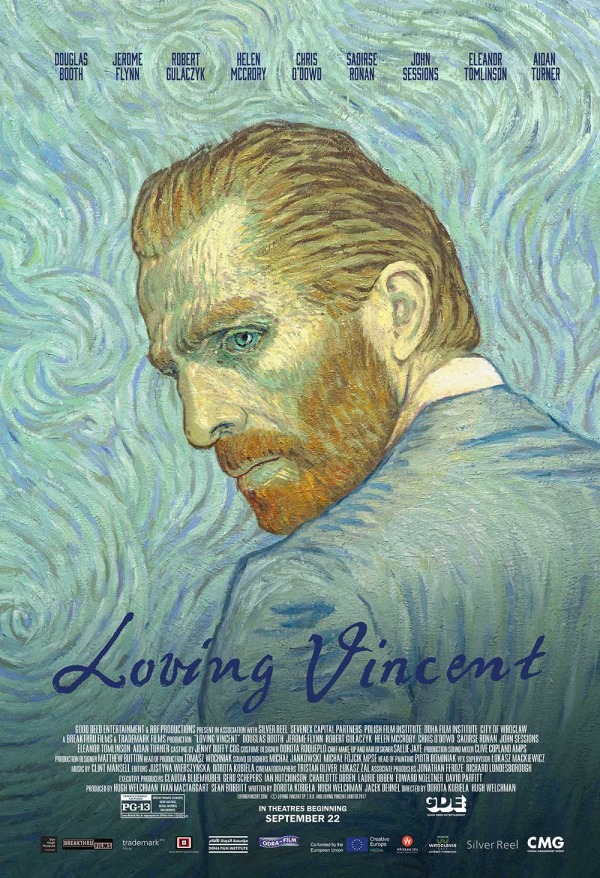
LOVING VINCENT (Dir. by Dorota Kobiela & Hugh Welchman, 94 min., USA, 2017)
 BY CHRISTOPHER MALENEY FILM CRITIC Vincent van Gogh is one of the most important modern artists, and one of the most enigmatic. Almost everyone has seen The Starry Night, his most iconic work. In monetary terms, his Portrait of Dr. Gachet is worth more than $82 million. There are museums, books, articles, whole careers dedicated to the study, analysis and display of his works. His use of color and form revolutionized the way artists perceive and portray the world. What is most interesting to a layman, however, is the mystery of the man himself. Was he sane? Was he depressed? Why did he take his own life? Did he take his own life, or was he murdered?
BY CHRISTOPHER MALENEY FILM CRITIC Vincent van Gogh is one of the most important modern artists, and one of the most enigmatic. Almost everyone has seen The Starry Night, his most iconic work. In monetary terms, his Portrait of Dr. Gachet is worth more than $82 million. There are museums, books, articles, whole careers dedicated to the study, analysis and display of his works. His use of color and form revolutionized the way artists perceive and portray the world. What is most interesting to a layman, however, is the mystery of the man himself. Was he sane? Was he depressed? Why did he take his own life? Did he take his own life, or was he murdered?
Loving Vincent takes all of these as its central questions, as Armand Roulin, son of the postmaster who befriended Vincent, seeks to deliver a letter from Vincent discovered after the man’s passing a year earlier. He travels to Paris to find Vincent’s brother, who has died only six weeks earlier, and then to Auvers-sur-Oise to deliver the letter to Dr. Gachet, a confidant of the family. While waiting for the Doctor to return to the town, Armand speaks to those who knew him, gathering their narratives of Vincent’s final weeks to try and understand the man who his father loved so dearly, and the circumstances surrounding his apparent suicide.
It takes a while to realize that you are actually in a detective movie, specifically an animated noir. In the film’s present narrative, every frame is a painting done by a team of more than a hundred artists in homage to van Gogh’s style. While mostly effective, there is an occasional slip into uncanny valley for certain faces. The paintings also make Armand’s story feel more beautiful than a standard noir. Only when we slip back to memories, drawn in crisp, clear black-and-white that contrasts with the impressionist present tense does the noir tone really come across. Still, the tropes are there: the hard-drinking, chain-smoking detective; the sadistic housekeeper, the beautiful femme fatale, and the bizarre and opaque mysteries of the small town all make appearances. So too does the beguiling, unanswerable question: was it suicide or murder? Each character, and each audience member, must pick their own meaning, their own version of Vincent’s life and death.
Vincent van Gogh was the ultimate outsider artist. He was never trained, but struggled every day to live authentically to his art. Perhaps that is what killed him. Perhaps it was the overwhelming forces of a world with no place for a visionary. Like so many artists, he became more famous after his death than in his life. What Loving Vincent does best is explore why, aesthetically and culturally, people love van Gogh’s work. Though its oil paints do not always best portray the characters search for understanding, it does help us inhabit for a brief 90 minutes the world of Vincent, a world of sublime beauty in small moments. It is an impressive technical feat, and works symbolically to delineate past and present, clear and hazy. While the narrative is perhaps too duty-bound to factual reality to give a satisfying conclusion — the truth of van Gogh’s death remains a mystery — it at least gives us a satisfying emotional journey that explores the beauty and genius of a then-unrecognized master.
